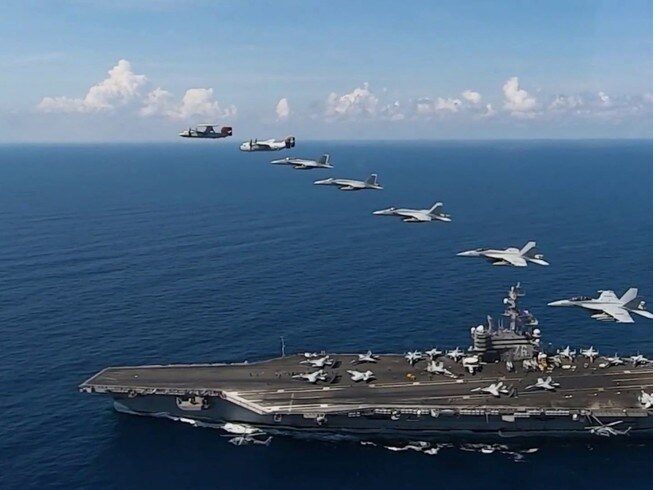
The US carrier comes as a "show of force" movement to deter possible North Korean provocations
North Korean news agency Yonhap quoted on Monday sources as saying that US nuclear-powered aircraft carrier USS Abraham Lincoln will access the international waters of the East Sea this week as a "show of force" movement to fend off any possible North Korean provocations.
The aircraft carrier along with a strike group will stay in the sea for about 5 days, Yonhap reported, adding that it will be the first incident of its kind since November 2017. The news agency quoted the spokesman for US Forces Korea, Lee Peters, as saying that "as a matter of operational security," he refuses to comment on the matter.
According to the news agency, the decision to send the carrier came as a result of fears of new missile launches by North Korea
in anticipation of Friday's 110th birth anniversary of its late founding leader Kim Il-sung and April 25's founding anniversary of the North Korean People's Revolutionary Army.
North Korea confirms testing its largest ICBM yetNorth Korea has stated that it tested a new powerful type of intercontinental ballistic missile (
ICBM), ending a self-imposed moratorium on long-range testing that had been in place since 2017.
State media reported on Friday, that North Korea's leader, Kim Jong-un, had personally guided the test of the Hwasong-17, a new type of intercontinental ballistic missile that is the country's largest to date.
The North Korean leader stated that his country would keep developing a "nuclear war deterrent" while preparing for a "long-standing confrontation" with the US.
The missile reportedly flew 1,090 kilometers (681 miles) to a maximum altitude of 6,248.5 kilometers (3,905 miles) before colliding with a target in the sea.
Kim ordered the test due to "daily-escalating military tension in and around the Korean peninsula" and the "inevitability of the long-standing confrontation with US imperialists accompanied by the danger of nuclear war," the state-run KCNA news agency reported.
The
successful test was described as a "striking demonstration of great military muscle" by KCNA, while Kim described it as a "miraculous" and "priceless" victory by the Korean people.
South Korean and Japanese military data showed that the missile flew higher and for a longer period of time than any of North Korea's previous tests before crashing into the sea west of Japan.It was the first full-capability launch of the state's largest missiles since 2017, marking a significant step forward in Pyongyang's weapon development.Biden and Japanese Prime Minister Fumio Kishida, who met at a Group of Seven summit in Brussels, condemned the North Korean launch, emphasized the importance of diplomacy, and agreed to work together to hold Pyongyang "accountable", according to a White House official.
Earlier, White House Press Secretary, Jen Psaki, said that "this launch is a brazen violation of multiple UN Security Council resolutions and needlessly raises tensions and risks destabilizing the security situation in the region."
It is worth mentioning that
Pyongyang had performed ten missile launches this year, more than in the whole year of 2021, before Thursday. According to
US, South Korean, and Japanese sources, two of North Korea's recent launches included components of the country's next-generation intercontinental
ballistic missile system.
Comment: See also:
- US to approve another arms deal with Taiwan totaling $940 million in the last year, in latest provocation against China
- The AUKUS issue is not over
- South Korea rejects claim it's helping Taiwan with 'indigenous defence submarine programme'
And check out SOTT radio's: NewsReal: Why You Should Question Media Reports About China 'Causing Covid' And 'Invading Taiwan'